Fernseh
The Fernseh AG television company was registered in Berlin on July 3, 1929 by John Logie Baird, Robert Bosch and other partners[1] with an initial capital of 100,000 Reichsmark. Fernseh AG did research and manufacturing of television equipment.[2]
Etymology
The company name "Fernseh AG" is a compound of Fernsehen ‘television’ and Aktiengesellschaft (AG) ‘joint-stock company’. The company was mainly known by its German abbreviation "FESE".[3] See section see also on this page for other uses.
Early years
In 1929 Fernseh AG's original board of directors included: Emanuel Goldberg, Oliver George Hutchinson (for Baird), David Ludwig Loewe, and Erich Carl Rassbach (for Bosch) and Eberhard Falkenstein who did the legal work.[3] Carl Zeiss's company worked alongside the early Bosch company. Much of the early work was in the area of research and development. Along with early TV sets (DE-6, E1, DE10) Fernseh AG made the first "Remote Truck"/"OB van", an "intermediate-film" mobile television camera in August 1932. This was a film camera that had its film developed in the truck and a "telecine" then transmitted the signal almost "live".[4]
Fernseh GmbH
- In 1939 Robert Bosch GmbH took complete ownership of Fernseh AG when Zeiss Ikon AG sold its share of Fernseh AG.
- In 1952 Fernseh moved to Darmstadt, Germany and increase its Broadcast product line.[5]
- In 1967 Fernseh, by then commonly called "Bosch Fernseh", introduced color TV products. Fernseh offered a full line of video and film equipment: professional video cameras, VTRs and telecine devices. On August 27, 1967 the first color TV program in Germany aired, with a live broadcast from a Bosch Fernseh outside broadcast (OB) van. The networks ZDF, NDR and WDR each acquired a new color OB van from Bosch Fernseh to begin broadcasting in color.
Fernsehanlagen GmbH
In 1972 Robert Bosch renamed its TV division: Fernsehanlagen GmbH (Fernseh facilities). The company supplied almost all the studio equipment for the 1972 Summer Olympics in Munich.
Fernseh Inc.
- In October 1979 Bell and Howell's TeleMation Inc. Division located in Salt Lake City, Utah, entered a joint venture with Robert Bosch GmbH, Bosch’s Fernseh Division. The new joint venture was call Fernseh Inc., Bosch Fernseh Division was located in Darmstadt, Germany
- In April 1982 Bosch fully acquired Fernseh Inc., renaming it "Robert Bosch Corporation, Fernseh Division"
- In 1986 Bosch entered into a new joint venture with Philips Broadcast in Breda, Netherlands. This new Company was called Broadcast Television Systems or BTS inc. Philips had been in the Broadcast market for many years with a line of PC- and LDK- Norelco professional video cameras and other video products.
- In 1995 Philips Electronics North America Corp. fully acquired BTS Inc., renaming it Philips Broadcast-Philips Digital Video Systems.
- In March 2001 this Philips division was sold to Thomson SA, the Division was call Thomson Multimedia. In 2002, the French electronics giant Thomson SA also acquired the Grass Valley Group from a private investor that had acquired it three years earlier from Tektronix in Beaverton, Oregon, USA. The current name of this division of Thomson is Grass Valley. The Fernseh's Darmstadt factory, near the Darmstadt Train Station and European Space Operations Centre was moved a short distance to Weiterstadt, Germany. (later, Grass Valley was sold to Belden on February 6, 2014, Belden also owns Miranda. )[6]
- Thomson Film Division, located in Weiterstadt including the product line of Spirit DataCine, Bones Work station, Scanity realtime film scanner and LUTher 3D Color Space converter, was sold to Parter Capital Group.[7] The sale was made public on Sept. 9, 2008 and completed on Dec. 1, 2008. The new Headquarters was still in Weiterstadt, the former Bosch Fernseh — BTS factory. Parter Capital Group continued to have worldwide offices to support products from Weiterstadt, Germany.[8][7] The new name of the company is Digital Film Technology.[9] DFT Digital Film Technology[10] became part of a new company: Precision Mechatronics GmbH in Weiterstadt, Germany.[11] On October 1, 2012 Precision Mechatronics and DFT were acquired by Prasad Group, part of Prasad Studios.[12][13] In 2013 DFT moved from Weiterstadt to Arheilgen-Darmstadt, Germany.
Products
- Home Television sets (later moved to the Blaupunkt Division) (1930- )[16][17][18][19][20][21][22]
- Home Radios (later moved to the Blaupunkt Division) (1930- )[23][24]
- Vacuum tubeTube tester[25]
- Early mechanical Camera for Mechanical television 1938, "Universal mechanical scanner"[26]
- Intermediate film system for Remote Truck (1936)[27][28]
- Filmgeber Film Chain F16LP15 Analog[29]
- Fernseh Theater TV system, 1935[30]
- TV transmitter 1944[31]
- Master control, B&W Video switcher[32]
- Sound recorder — player, Diaabtaster DAT15, Fernseh[33]
- B & W Film Chain[34]
- OMY Color Film Chain - Analog[35]
- BCM-40 and B&W BM-20 2 inch Quadruplex videotape 1966-70s[36][37]
- B & W cameras like Videokamera s/w K11 VK9 HA[38][39]
- M series monitors[40][41]
- TV Oscilloscope[42][43]
- Video-signal generators[44]
- Television standards conversion(1970s) Analog Model NC 56 P 40, with Plumbicon tube camera inside.
- BCR pre BCN VTR[45]
- BCN series 1 inch type B videotape (1979–1989) Analog VTR[46]
- KC series color professional video camera KCU-40,[47][48] KCR,[49] KCK-40, KCK-R-40, KCP-40, KCP-60, KCA, KCF-1, KCM-125, KCA, KCN92, KCN(1967–1990),[50][51][52][53][54][55][56][57][58][59][60][61]
- Color film chain, with KCU-40 camera[62]
- MC series color and B&WVideo monitorMC-37, MC-50 MCH 51, MH 21[63][64][65]
- OB Van - TV Remote Trucks - and Terminal Rack Equipment[66][67]
- RME series Mixers — Switcher - Vision mixer, Analog[68]
- FDL-60 Telecine - The world's first CCD telecine (1979–1989)
- FRP-60 Color Corrector-Color grading (1983–1989)[69]
- FDL-90 Telecine (1989–1993) (now under BTS)
- Noise/Grain Reducer: FDGR, DNR7, MNR9, MNR10, MNR11, VS4, Scream, Scream 4k[70][71][72]
- KCA-110 ENG Camera
- KCF-1 ENG Camera (later Quartercam, not sold)[73][74][75]
- CCIR 601 Products CD7, DC7, 4X4 Booster, Test Gen. Encoders, Decoders.
- DD series CCIR 601-D1 Mixers - Vision mixer DD5, DD10, DD20, DD30[76]
- DCR series D1 VTR DCR-100 DCR-300 DCR-500
- BCH 1000 HDTV 1" VTR
- KCH 1000 HDTV camera (RMH 1000)[77][78]
- FLH 1000 Telecine The world's first HDTV CCD Telecine (1994–1996)
- Quadra 4:4:4 Telecine (1993–1998)
- D6 HDTV VTR Uncompressed HDTV VTR (VooDoo)-(Gigabit Data Recorder (2000–2006) (Now under Philips)
- Spirit DataCine Motion picture film scanner and HDTV Telecine SDC-2000 (1996–2006) also: SDC2001, SDC2002
- Phantom Transfer Engine Software for Spirit Datacine Telecine for Virtual telecine(1998-)
- Shadow HDTV Telecine STE (2000–2006)
- VDC-2000 Specter Virtual telecine (1999–2002)
- Specter FS Virtual telecine (2002–2006)
- Spirit DataCine 4k Datacine - Telecine (2004- ) also Spririt Spirit 2k/Spirit-HD (now Under Thomson-Grassvalley)
- Bones Linux-Based Software for Spirit Datacine Telecine Transfer Engine Software (2005-2014 )
- Bones Dailies (2008-2014)
- LUTher 3D LUT Color Space (2005- )[79]
- Flexxity (2011-2014)
- Scanity film scanner (2009- )[80][81][82][83][84][85][86] (Now under DFT)
- Phantom 2: Linux-Based transfer Engine software and workstation for Spirit Datacine (2014-)[87] (Now under DFT)
Photo gallery
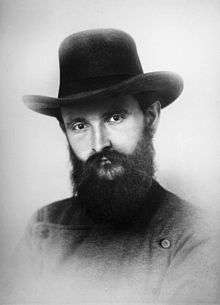 Robert Bosch in 188
Robert Bosch in 188 Intermediate film system for first Remote Truck (1936)
Intermediate film system for first Remote Truck (1936)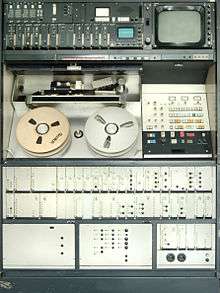 BOSCH Quad VTR Model BCM 40
BOSCH Quad VTR Model BCM 40 BCN 51 Fernseh VTR
BCN 51 Fernseh VTR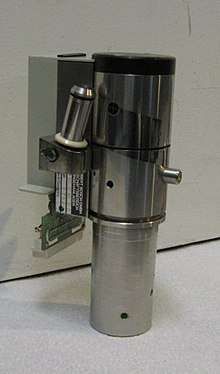
- Bosch Fernseh FDL 60 Telecine Film Deck and Lens Gate
- FRP 60 Control Panel, Bosch Fernesh
 BCN 52 VTR
BCN 52 VTR BCN 20 VTR with "L unit" playback with TBC.
BCN 20 VTR with "L unit" playback with TBC.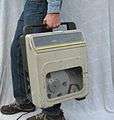 BCN 20 VTR hand held VTR recorder.
BCN 20 VTR hand held VTR recorder.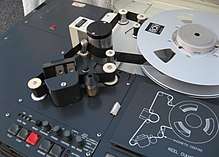 BCN 20 VTR deck
BCN 20 VTR deck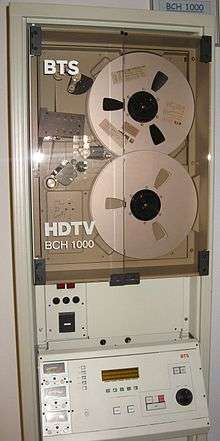 BCH-1000 HDTV B VTR
BCH-1000 HDTV B VTR QUATERCAM BCF studio VTR (Lineplex system)
QUATERCAM BCF studio VTR (Lineplex system)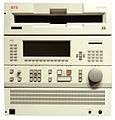 D1 DCR 500 VTR
D1 DCR 500 VTR- BOSCH KCK-40
 KCM-125 SDTV camera with a Schneider Optics Lens
KCM-125 SDTV camera with a Schneider Optics Lens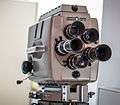 KOD 3 television studio camera
KOD 3 television studio camera Bosch Fernseh HQ_Darmstadt, Germany
Bosch Fernseh HQ_Darmstadt, Germany Bosch Fernseh HQ street sign Darmstadt Germany
Bosch Fernseh HQ street sign Darmstadt Germany Fernseh Inc. Logo
Fernseh Inc. Logo Bosch Video Corp. logo
Bosch Video Corp. logo D6 VTR Tape Deck
D6 VTR Tape Deck D6 VTR Scanner, removed
D6 VTR Scanner, removed Inside a D6 VTR Tape Deck
Inside a D6 VTR Tape Deck D6 VTR full unit
D6 VTR full unit- SDC-2000 Spirit DataCine Film Deck
- Quadra Telecine Film Deck
- SDC-2000 Spirit DataCine Functional Control Panel-FCP
 Spirit Datacine 4k with the doors closed
Spirit Datacine 4k with the doors closed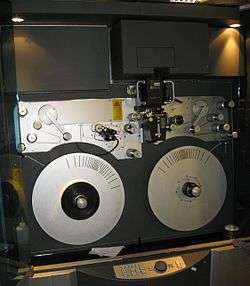 Spirit Datacine 4k with the doors open.jpg
Spirit Datacine 4k with the doors open.jpg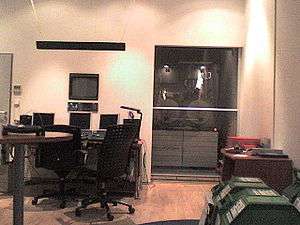 A Shadow Telecine in a color correction suite.
A Shadow Telecine in a color correction suite. GCP for a Spirit Datacine
GCP for a Spirit Datacine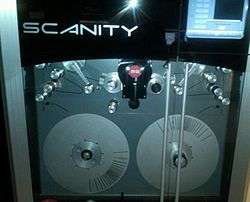 Scanity Film Deck
Scanity Film Deck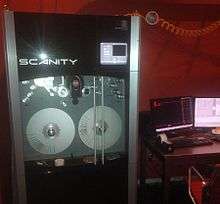 Cinelicious Scanity 4k and work station
Cinelicious Scanity 4k and work station
Offices
Past and current offices in the cities of acquisitions (see History):
- Cergy, France (Thomson World Headquarters)
- Salt Lake City, Utah, United States - from TeleMation Inc -Bell and Howell
- Beaverton, Oregon, United States- from Tektronix
- Nevada City, California, United States — from Grassvalley Group
- Breda, Netherlands - from Philips - Norelco
- Weiterstadt - Darmstadt, Germany from Bosch Fernseh-(DFT),
- In 2013 DFT moved from Weiterstadt to Arheilgen-Darmstadt, Germany.
See also
- Post production
- Professional video camera
- Telecine
- TV
- Video camera
- Fernseh prefix:
- Fernsehturm Berlin Television Tower.
- Fernsehen German for Television.
- Fernseh sprechstellen German Videotelephony.
- Fernsehturm Stuttgart telecommunications tower in Stuttgart.
- Fernsehsender Paul Nipkow first public television station in the world.
- Fernsehturm (disambiguation) German word for television tower.
- Fernsehen der DDR state television broadcaster in East Germany.
- Fernsehturm Heidelberg Heidelberg transmission tower.
- Fernsehturm Dresden-Wachwitz TV tower in Dresden.
- Fernsehserien German for TV series which comprises several episodes.
- ZDF Fernsehgarten "ZDF Television garden" is a German entertainment show.
- Deutscher Fernseh-Rundfunk Early German Television Broadcasting
- Fernsehproduktion a television production.
- Fernsehnorm TV standard.
- Fernsehpitaval Crime TV show from 1958 to 1978 on GDR.
References and notes
- ↑ Darmstadt, Fernseh (Fernseh AG, GmbH, FESE, Bosch Fernsehanlagen); Berlin -. "Fernseh ; Berlin - Darmstadt manufacturer in D, Model types,".
- ↑ Fernsehmuseum - Sie sind im Bereich : Fese Historie Start
- 1 2 The Bosch Group - Published in 2004
- ↑ Sie sind auf der Homepage von Fernsehmuseum Wiesbaden: Fese Historie 1
- ↑ Fiona. "Farvis TV museum Pfungstadt".
- ↑ "Belden Announcement".
- 1 2 "PARTER Capital Group - Gesellschaft für Beteiligungsberatung".
- ↑ "Creative Planet Network".
- ↑ "Digital Film Technology GmbH - Scanity - HDR Film Scanner".
- ↑ dft-film.de - DFT Digital Film Technology - Manufacturer of CCD based telecines and data scanners
- ↑ "Digital Film Technology GmbH - Scanity - HDR Film Scanner".
- ↑ Group, Prasad. "Prasad Corp - Visual Effects - Digital Archive - Digital Film Restoration - Media Asset Management - Digital Intermediate".
- ↑ DFT Press Release, Weiterstadt, Germany – October 1, 2012 Archived August 31, 2013, at the Wayback Machine.
- ↑ radiomuseum.org Fernseh Product list
- ↑ tvcameramuseum.org List of Fernseh Product
- ↑ tvhistory.tv Television History — The First 75 Years, 1935-1941, Fernseh German Television Sets
- ↑ tvhistory.tv Television History — The First 75 Years, 1950-1959 Fernseh German Television Sets
- ↑ radiomuseum.org Fernseh DE8R model TV, 1939
- ↑ tvhistory.tv Television History — The First 75 Years
- ↑ tvhistory.tv Television History — The First 75 Years, 1936 German (Berlin) Olympics
- ↑ earlytelevision.org Fernseh AG TV sets
- ↑ fernsehen.bplaced.net German prewar TV sets, Producer Fernseh AG
- ↑ radiomuseum.org Fernseh, DE6R Radio, 1938
- ↑ fernseh-gmbh.de TV museum Pfungstadt
- ↑ radiomuseum.org 1949, Fernseh, Vacuum Tube tester, Farviprüfer
- ↑ radiomuseum.org 1938, Universal mechanical scanner, Mechanischer Universal Abtaster
- ↑ School of Information Management & Systems, Michael Buckland, Professor. Emanuel Goldberg, Television & Zeiss Ikon.School of Information Management & Systems, Michael Buckland, Professor. Emanuel Goldberg, Television & Zeiss Ikon, "Fernseh AG made considerable technical advances, ... they developed amazing "intermediate" systems that combined film and television technology both for sending and for receiving."
- ↑ Technological history of motion pictures and television By Raymond Fielding
- ↑ radiomuseum.org Fernseh, Filmgeber F16LP15, 1959
- ↑ yearlytelevision.org Fernseh Theater TV system, December 1935
- ↑ Fernsehsender / TV transmitter Fernseh GmbH 1944
- ↑ radiomuseum.org Regieanlage, directed system, control room
- ↑ radiomuseum.org Fernseh Diaabtaster DAT15
- ↑ radiomuseum.org Fernseh Filmgeber Telecine 1968
- ↑ Deutsches Fernsehmuseum Wiesbaden OMY, Film Chain, German site
- ↑ radiomuseum.org Magnetbandanlage BC M 40A, 1966
- ↑ BM-20 B & W Quad TVR photo
- ↑ radiomuseum.org Fernseh, Videokamera s/w K11 VK9 HA, 1975
- ↑ radiomuseum.org Fernsehkamera DFFB (KOD) 1958
- ↑ radiomuseum.org Kontroll-Monitor M32BA28 1960
- ↑ M21BC9F 1965
- ↑ radiomuseum.org Oscilloscope, Fernseh, Kontroll-Monitor und Oszilloskop EOv25-75, 1955
- ↑ radiomuseum.org lab, Oscilloscope, Fernseh
- ↑ Ukkola. "Prüfsignalgebersatz PGM 408-003 Equipment Fernseh Fernseh AG".
- ↑ vtoldboys.com The Bosch/Philips BCR 1" helical scan that was shown in 1973 and preceded the BCN.
- ↑ "1979 Miss Universe BCNs".
- ↑ broadcasting101.ws KCU-40
- ↑ broadcasting101.ws KCU-40 rear
- ↑ "bosch portatil".
- ↑ Summers, Brian. "Bosch KCK-40 Television Camera 45° view".
- ↑ Oldboys website Picture of a Bosch KCR-40 and KCA-100 Camera
- ↑ Summers, Brian. "Bosch KCA-100 Television Camera".
- ↑ broadcasting101.ws Four Bosch cameras, photo only
- ↑ broadcasting101.ws Setup Camera
- ↑ broadcasting101.ws Bosch Cameras, 1978 Games, photo only
- ↑ tvcameramuseum.org list of Bosch cameras
- ↑ fernseh-gmbh.de Farvis TV-Museum Pfungstadt, Fernseh Cameras
- ↑ oldtvgear.com kcu-40 page
- ↑ "bosch kck 40, original del 78".
- ↑ "Camera Manufacturers List".
- ↑ KCN-92 open
- ↑ oldtvgear.com Color film chain, with Bosch Fernseh KCU-40 camera as PU
- ↑ adiomuseum.org MC473BA B&W monitor
- ↑ www.adsausage.com Bocsh MC monitor add
- ↑ broadcasting101.ws
- ↑ Bosch made Olympiad 1972 Control Room
- ↑ Bosch OB Van
- ↑ "Mixer Bosch Fernseh - a photo on Flickriver".
- ↑ [FRP 60 Control Panel Bosch Fernesh.JPG FRP 60 Control Panel Bosch Fernesh]
- ↑ Noise reduction, Bosch FDGR
- ↑ Bosch Noise reduction, FDGR, control panel
- ↑ Noise reduction, MNR
- ↑ "Archive photos R01".
- ↑ "loreoutlet.dyndns.org on KCP".
- ↑ The History of Television, 1942 to 2000, By Albert Abramson, Christopher H. Sterling
- ↑ DD10 Switcher
- ↑ live-production.tv A Brief Review on HDTV in Europe in the early 90’s
- ↑ Summers, Brian. "Bosch KCH1000 Television Camera".
- ↑ videoengineer.net LUTher manual
- ↑ DFT's SCANITY Audio Option Datasheet
- ↑ "Cinelicious". 12 March 2011.
- ↑ "Cinelicious Installs Scanity - Below the Line". 26 April 2011.
- ↑ "Mercury Post Installs SCANITY Film Scanner - Below the Line". 12 October 2010.
- ↑ "Spice Shop Installs SCANITY High-Speed Film Scanner - Asia-Pacific News".
- ↑ Scanity and Sprit Datacine in a control room
- ↑ Shoot online, SHOOT Publicity Wire, OMNIMAGO Invests in SCANITY for New Production and Archive Scanning Projects, March 22, 2011
- ↑ dft-film.com, Phantom-II in pdf